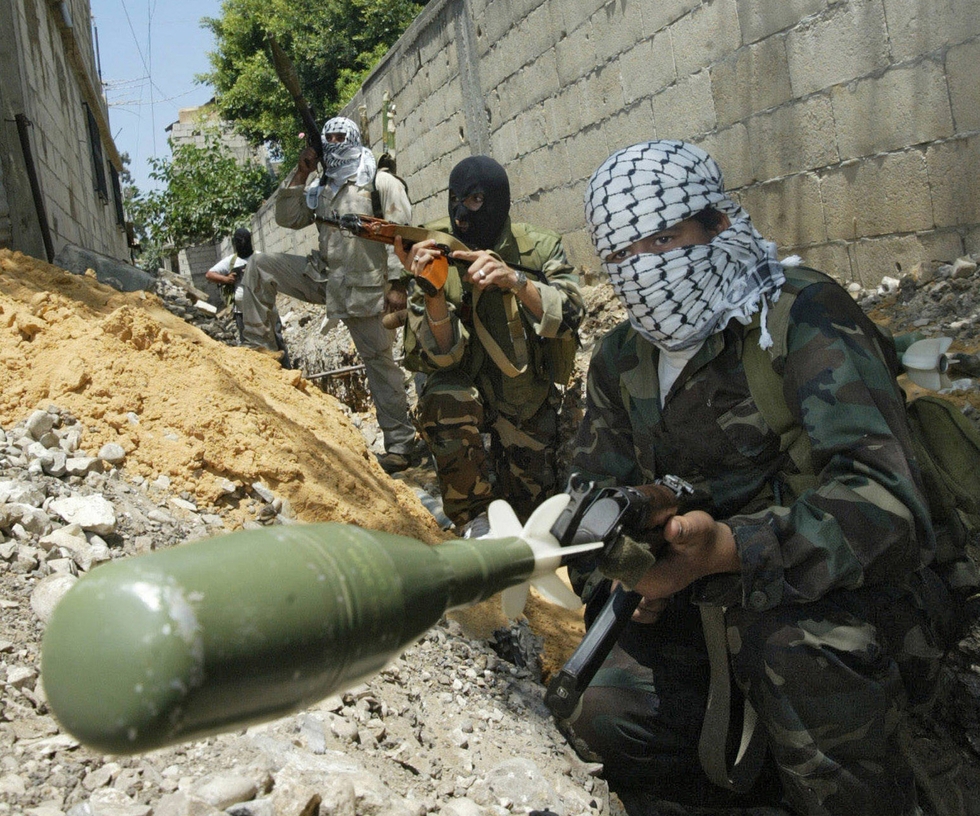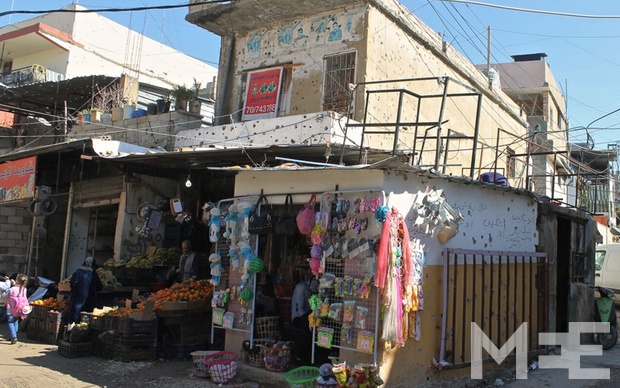The struggle to keep the peace in Lebanon's largest Palestinian refugee camp

AIN AL-HILWEH, Lebanon - On Fouqany street, one of two main thoroughfares in Ain al-Hilweh, the facades of many buildings stand pock-marked by bullet-fire.
Posters depicting Yasser Arafat hang from awnings alongside black and white Salafist flags, while haphazard networks of electricity wire feed power to Lebanon's largest Palestinian camp, where few outsiders go and fears about the rise of the militants, including the Islamic State (IS) group, are growing.
Nearby, in a four-storey facility guarded by gunmen in military fatigues, Fatah Major General Mounir Maqdah sat composed as he described the security situation in the camp, home to between 90,000 and 120,000 people living in endemic poverty in a one-square-kilometre area surrounded by Lebanese army checkpoints.
Last summer this Palestinian refugee camp in Sidon, regarded as Lebanon’s most volatile, witnessed a series of assassinations and gun battles.
These pitted the Palestinian nationalist Fatah movement, the predominant military authority in the camp, and its allies against armed religious militant groups led by the al-Qaeda-linked Jund al-Sham.
The violence left at least six people dead, injured over 70, and forced thousands to temporarily seek shelter outside the camp.
While a restive calm has since returned, Lebanese security forces remain wary that Ain al-Hilweh could pose further security threats in 2016. Earlier this month, reports emerged that young men from the camp were travelling to Raqqa, Syria to join IS there, sparking fears they could soon come back to try to enforce strict Islamist rule back home.
“The gun battles last year were very bad, the worst in a long time,” Ibtisam Mosri, a 39-year-old camp resident, told Middle East Eye.
“Now, things seem calm, but there are divides in the camp, neighbourhoods that people do not go to. People are always afraid of more violence.”
Keeping the peace
For almost a decade, religious groups have tried to make inroads in Lebanese Palestinian camps. The Lebanese Army does not enter Ain al-Hilweh, or any of Lebanon’s other 11 Palestinian camps, in accordance with the 1969 Cairo Accord. Instead, the camps tend to be self-governed by Palestinian political and security forces.
In 2007 the Lebanese Army fought a month-long conflict with Fatah al-Islam after the group overran the Palestinian camp of Nahr al-Bared in northern Lebanon. The camp was totally levelled and its 30,000 residents were displaced for years. Clashes also took place in Ain al-Hilweh, but those calmed down.
More recently in Syria, IS took over large parts of Yarmouk, a Palestinian camp located in Damascus.
The realities, mixed with Lebanon’s fraught history with its Palestinian population, have put the Lebanese state on edge and prompted action.
In April last year, meetings between Palestinian factions in Ain al-Hilweh and Lebanese security officials led to the establishment of a Joint Security Force in Ain al-Hilweh in order to prevent recurring clashes between rival factions and the infiltration of al-Qaeda-linked elements into the camp.
Headed by Maqdah, a PLO veteran perceived to have favourable ties with Hezbollah, the Joint Security Force comprises 225 fighters from all 17 of Ain al-Hilweh’s Palestinian factions. These include secular Palestinian nationalist, Marxist, and Islamist factions, including Al-Qaeda linked groups such as Fatah al-Islam and Osbet al-Ansar.
“The factions in the camp are united,” said Maqdah, in reference to the Joint Security Force. “The whole [Middle East and North Africa] region is undergoing an earthquake, and we are working with the Lebanese state to stop extremist groups infiltrating all the camps in Lebanon.
“There are some people in the camp that support IS and al-Nusra, but they are small in number. The security situation in the camp is excellent,” he said.
However, some Ain al-Hilweh residents who spoke to MEE feared a return to violence, sceptical of the capability of the Joint Security Force to keep the peace, with the fragile agreement already being severely tested.
“People continue with everyday life,” said Souad Oweid, a woman in her forties who grew up in Ain al-Hilweh and attended university in Libya. “But there is tension under the surface.”
Syria spillover
Since the start of Syria’s civil war, religious groups in Ain al-Hilweh, emboldened by the endeavours of al-Nusra Front and IS, have increasingly sought to challenge traditional power structures in the camp.
These challenges have predominantly been led by Jund al-Sham. But other armed radical groups such as Shabab al-Muslim, a group with claimed links to al-Nusra, have also emerged out of the yoke of pre-existing al-Qaeda linked, but less volatile, factions such as Fatah al-Islam and Osbet al-Ansar, attracting younger residents of the camp.
Jund al-Sham, a small militant anti-Fatah Salafist group, was founded in Ain al-Hilweh in 2004, and its allies enjoy a particularly strong presence in certain enclaves such as the Tawary and Tameer neighbourhoods, in the north of the camp.
Speaking to MEE, Abu Wissam, a member of the Democratic Front for the Liberation of Palestine (DFLP) who also serves on Ain al-Hilweh’s Joint Security Force, said that since last summer’s violence the organisation has been wary of patrolling such areas.
In July 2015, fighting between Fatah and Jund al-Sham broke out after Talal al-Ourdani, a senior Fatah official, was assassinated while walking with bodyguards near the entrance of a school and social centre run by the NGO Nabaa.
“When I heard gunfire I didn’t think much - it is common here,” recalled Hashem Hachem, a Nabaa employee who grew up in the camp.
“But then I heard screaming. I ran outside the front gates and quickly with other colleagues tried to gather the children back inside. Rivers of blood were forming on the pavement.”
Soon after al-Ourdani’s death, divisions emerged within Ain al-Hilweh’s Joint Security Force.
Many members sided with Jund al-Sham, which temporarily overran four of the camp’s 11 districts.
While the force was able to regain much of the lost ground, the various religious factions continue to carry serious influence.
In September, Hachem’s colleague Ali Saleh, Nabaa’s Sidon area officer, became embroiled in a disagreement over Nabaa services in the camp with an affiliate of Shabab al-Muslim.
“This person wanted us to refurbish a shop he owned near the vegetable souq. But this was not what the funds had been allocated for,” said Saleh. “I received threats, I feared for my life.”
After the incident, Saleh did not return to Ain al-Hilweh for a month until he received assurances of his safety through a mediator: Jamal Khattab, the head of the Islamic Jihad political movement. While Khattab has been accused of recruiting local residents to fight with Syrian rebel groups, the Islamic Jihad chief also maintains cordial relations with Hezbollah and is said to have received financial backing from Iran.
“There are people here that can commit acts and there are no repercussions,” Saleh said.
In a small, neat office on Tahtany Street, Khattab leader said that the efficacy of the Joint Security Force was limited.
“All factions are included but the force lacks top-down authority. In certain cases like murder, to take a murderer with connections to jail is not easy. He has family, supporters; they might try to spark clashes to prevent him going to jail,” said Khattab, who has arbitrated disputes between Fatah and Jund al-Sham and also maintains cordial relations with Hezbollah.
“For example, recently two people from the same party had a shoot-out, so they solved it internally, not through the General Force.”
Hachem said the Joint Security Force remained unaware of some events that take place in Ain al-Hilweh, explaining that two weeks ago, a resident of Tameer suddenly disappeared.
“He was a quiet guy, 24, a finance graduate,” Hachem said, and suggested that the Tameer resident had travelled to Syria to join a militant group.
“He is not the first. We have spoken to his family, and the camp security force, even Lebanese General Security. No one has any information.”
Sitting beside Hachem in a second-floor office in Nabaa’s centre, Haneen, a 47-year-old woman who did not want to give her real name, sat with her hands clasped tightly, a furrow in her brow. During last summer’s clashes, Haneen was widowed when her husband, a member of Fatah, was killed fighting Jund al-Sham.
For three months, Fatah paid Haneen the equivalent of her husband’s salary, but this payment has since stopped, making it increasingly difficult for Haneen to make ends meet.
Palestinians living in Lebanon face state-imposed restrictions against their access to mainstream job markets, a reality that has traditionally perpetuated poverty and fuelled militia recruitment in camps such as Ain al-Hilweh.
Like Hachem and others, Haneen expressed doubt over the Fatah-led Joint Security Force’s ability to keep the peace.
“I don’t know if my husband died defending a cause,” said Haneen stoically. “But I know more violence will come.”
New MEE newsletter: Jerusalem Dispatch
Sign up to get the latest insights and analysis on Israel-Palestine, alongside Turkey Unpacked and other MEE newsletters
Middle East Eye delivers independent and unrivalled coverage and analysis of the Middle East, North Africa and beyond. To learn more about republishing this content and the associated fees, please fill out this form. More about MEE can be found here.





